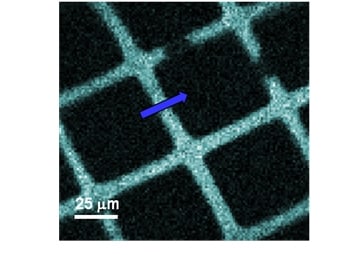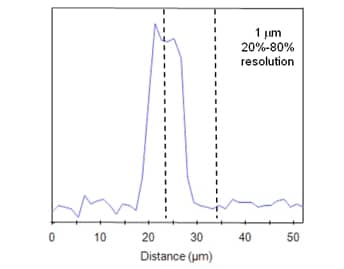Search

Materials Science
X-Ray Photoelectron Spectroscopy Imaging
Imaging and mapping with X-ray photoelectron spectroscopy.
X-ray photoelectron spectroscopy imaging
While used to identify points or small features at the surface, XPS can also be used to image the surface of a sample. This is useful in understanding at the distribution of chemistries across a surface, for finding the limits of contamination, or even examining the thickness variation of an ultra-thin coating. There are two approaches for obtaining XPS images: mapping (serial acquisition) or parallel imaging (parallel acquisition). In this section we will describe how both of these approaches work, and the benefits of each approach.
X-ray photoelectron spectroscopy serial acquisition
Serial acquisition of images is based on a two-dimensional, rectangular array of small-area XPS analyses. This method enables measurements of the distribution of elements or chemical states. The ultimate spatial resolution in the image is determined by the size of the smallest analysis area, for example on the Thermo Scientific Nexsa Surface Analysis System this is 10 μm. Serial acquisition is generally slower than parallel acquisition but can collect a range of energies at each pixel compared with collecting only a single energy for parallel acquisition.
Used in combination with a multi-channel detector, serial acquisition of maps can result in ‘snapshot’ spectra being produced at each pixel. The Thermo Scientific
K-Alpha and Nexsa XPS Instruments can scan the sample stage to obtain images. Using this method, the analysis position is fixed and the specimen surface is moved with respect to this position.
Advantages of X-ray photoelectron spectroscopy mapping
- The energy of the X-ray beam remains constant throughout the image
- The map resolution is independent of position within the map
- The transmission function of the lens is independent of position in the map
- The maximum size of the image field of view is limited only by the range of motion of the specimen stage
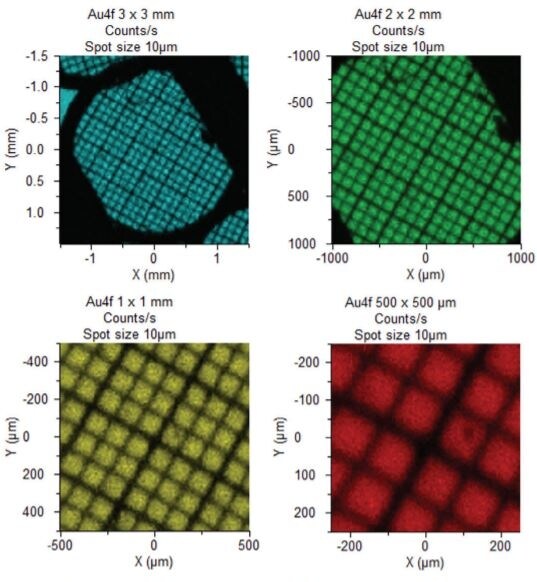
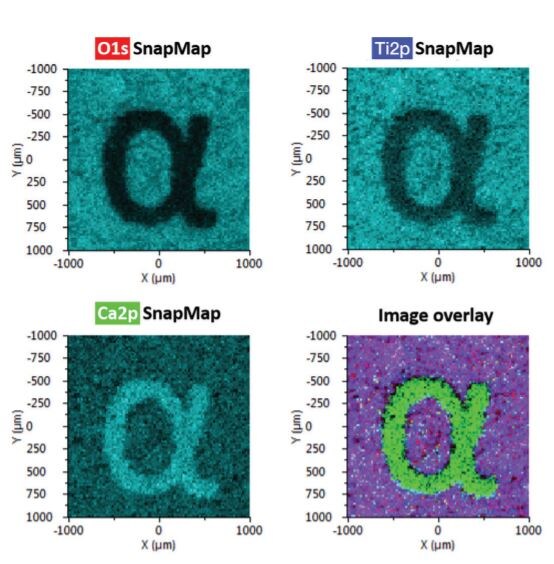
X-ray photoelectron spectroscopy parallel imaging
Instrument components necessary for parallel acquisition of photoelectron images using the Thermo Scientific ESCALAB Xi+ XPS Instrument.
Parallel acquisition of photoelectron images is easily achieved using the Thermo Scientific ESCALAB Xi+ Instrument. This method simultaneously images the entire field of view without scanning voltages applied to any spectrometer component. For parallel acquisition, additional lenses equipped with a two-dimensional detector are required. The photoelectrons pass through lenses 1 and 2 in the transfer lens assembly, producing a photoelectron image of the specimen surface at some plane within the lens column after each lens (the image planes). Lens 3 is operated such that its focal length is equal to the distance between the lens and the second image plane. Therefore, electrons emanating from any point on the image will leave lens 3 on parallel paths. The angle between the beam of electrons and the lens axis will depend on their distance from the lens axis in the image plane. The electrons then enter the analyzer, which functions as both an energy filter and a lens. If the analyzer’s deflection angle is 180°, then the angular distribution of the electrons is retained as they leave the analyzer. A fourth lens (lens 4) operated in the reverse manner of lens 3 will reconstruct the image at a two-dimensional detector placed at the focal length of lens 4. The electrons forming the image have passed through the energy analyzer and by tuning the analyzer to the energy of a photoelectron peak, a chemical image is constructed.

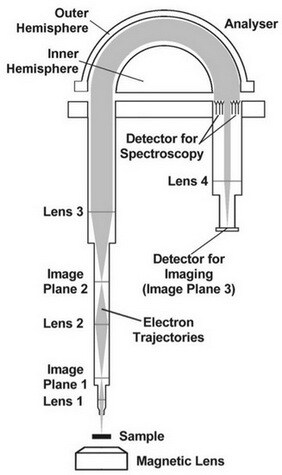
The spatial resolution of parallel imaging depends on the spherical aberrations in the lens. Limiting the angular acceptance of the lens can reduce the effect of the aberrations, which improves resolution at the expense of sensitivity. The use of a magnetic immersion lens in the specimen region also reduces aberrations, producing higher sensitivity at a given resolution. This method of imaging is fast and produces the best possible imaging resolution.
Parallel Imaging provides the best resolution and is faster than serial methods for producing an image at a single energy. Spectroscopy from images is possible by collecting a series of images at different energies across each peak required, effectively running a scanned XPS acquisition for each pixel in the image.
